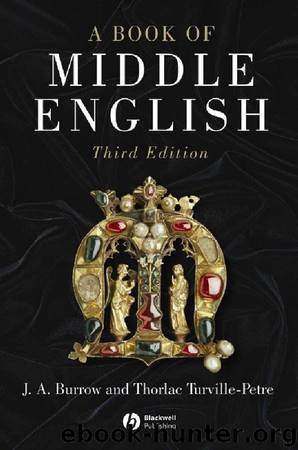A Book of Middle English by Burrow J. A. & Turville-Petre Thorlac

Author:Burrow, J. A. & Turville-Petre, Thorlac [Burrow, J. A.]
Language: eng
Format: azw3
Publisher: Wiley
Published: 2013-04-02T16:00:00+00:00
11
St Erkenwald
The alliterative poem St Erkenwald survives in just one manuscript, British Library MS Harley 2250. This copy was made in 1477, but the poem was most likely composed in the 1390s or early 1400s. The dialect of the copy is assigned by the Linguistic Atlas to Cheshire; and the opening reference to London in Englond points to the same county (see 1n.). Nothing is known of the author’s identity. So far as linguistic evidence goes, the poem might have been written by the author of Sir Gawain and the Green Knight (text 9 here) – to whom, indeed, it has sometimes been ascribed. Yet its style tells against this identification: it is less exuberant, sparer and more concise. See also Benson (1965).
Like Chaucer’s Prioress’s Tale (text 18b here), the poem would have been described in the Middle Ages as a miraculum or ‘miracle’. Its subject is a miracle brought about through the agency of Erkenwald, an Anglo-Saxon saint of the seventh century. Erkenwald was Bishop of London, and his cult was celebrated there at St Paul’s Cathedral – an episcopal church with which the poet may well have had connections. The miracle in question does not figure elsewhere in the saint’s dossier. It appears to have been a pious invention of the poet himself, suggested by similar stories concerning St Gregory’s part in the posthumous salvation of a pagan Roman emperor, Trajan. Like these, the Erkenwald story addresses a large theological question which medieval Christians found troublesome: could those who lived virtuously according to their lights, but without knowledge of the Christian faith, be saved? And if so, how? In the B Text of Piers Plowman (XI 141–69, XII 281–92) Langland gives a liberal version of the Trajan story: the emperor was so outstandingly just and merciful that it required only the longings and tears of Gregory to bring him out of hell. But a different version, found in an early commentary on Dante’s Commedia, makes Trajan’s salvation depend on his being resuscitated and baptized by Gregory; and this is closer, in its theological conservatism, to the Erkenwald story. See Whatley (1986). In the Middle English poem it is indeed the pagan judge’s outstanding virtues which induce God to preserve his body and clothes undecayed (ll. 267–70); but his soul is not admitted to heaven until the saint has administered the sacrament of baptism – the climax of the poem (316n.). So here, as not in Langland, the Church and its sacraments have an essential part to play.
The vivid and sharply focused narrative matches the clarity of the theology it serves. The poem is divided exactly into two equal halves (177n.). The first half is devoted to the discovery of the corpse and the bishop’s solemn preparations for his encounter with it; the second half describes that encounter in dialogue which, with deceptive naturalness, answers precisely all the questions raised by the strange contents of the tomb (questions put by the bishop, ll. 185–8). The baptismal climax is a tour de force of the theological imagination.
Download
This site does not store any files on its server. We only index and link to content provided by other sites. Please contact the content providers to delete copyright contents if any and email us, we'll remove relevant links or contents immediately.
| African | Asian |
| Australian & Oceanian | Canadian |
| Caribbean & Latin American | European |
| Jewish | Middle Eastern |
| Russian | United States |
4 3 2 1: A Novel by Paul Auster(11132)
The handmaid's tale by Margaret Atwood(6924)
Giovanni's Room by James Baldwin(5986)
Big Magic: Creative Living Beyond Fear by Elizabeth Gilbert(4788)
Asking the Right Questions: A Guide to Critical Thinking by M. Neil Browne & Stuart M. Keeley(4651)
On Writing A Memoir of the Craft by Stephen King(4274)
Ego Is the Enemy by Ryan Holiday(4062)
Ken Follett - World without end by Ken Follett(4012)
The Body: A Guide for Occupants by Bill Bryson(3903)
Bluets by Maggie Nelson(3769)
Adulting by Kelly Williams Brown(3726)
Guilty Pleasures by Laurell K Hamilton(3642)
Eat That Frog! by Brian Tracy(3582)
White Noise - A Novel by Don DeLillo(3478)
The Poetry of Pablo Neruda by Pablo Neruda(3415)
Alive: The Story of the Andes Survivors by Piers Paul Read(3352)
The Book of Joy by Dalai Lama(3284)
The Bookshop by Penelope Fitzgerald(3270)
Fingerprints of the Gods by Graham Hancock(3264)
